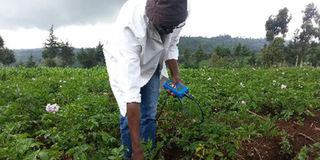Protecting your soil to give you a bumper crop all year round

A soil expert checks on the quality of soil. Conservation agriculture utilises soils for the production of crops with the aim of reducing excessive use of the soil and maintaining crop residues on the soil surface in to minimise damage to the environment. FILE PHOTO | NATION MEDIA GROUP
What you need to know:
- Instead of ploughing and harrowing, the soil could be sub-soiled using a sub-soiler and then ripped using a ripper to make furrows for seed placement.
- Conservation agriculture promotes the proper management of crop residues where they are placed carefully between rows during land preparation in the dry season.
- Hand-powered options include the planting basin and the furrow. Farmers with draught power can make use of a ripper tine.
- The farmers can put compost or manure in the holes to raise the soil fertility and the water-holding capacity and then sow maize or beans.
Conservation agriculture is a system that utilises soils for the production of crops with the aim of reducing excessive use of the soil and maintaining crop residues on the soil surface in order to minimise damage to the environment.
It involves three major principles namely minimum soil disturbance, maintaining soil cover and crop rotation.
1. Minimum soil disturbance
The key principle is to move the soil as little as possible. Only disturb the soil where the seed and fertility amendments such as fertiliser and manure are to be placed.
Instead of ploughing and harrowing, the soil could be sub-soiled using a sub-soiler and then ripped using a ripper to make furrows for seed placement.
Alternatively, direct planting could be done using a hand operated jab planter, animal or tractor drawn direct planter, dibbler or hand hoe.
Such equipment can be used to plant with minimal disturbance of the soil.
2. Cover the soil as much as possible
Traditionally crop residues are burned after harvesting or animals allowed to freely graze in the fields.
Conservation agriculture promotes the proper management of crop residues where they are placed carefully between rows during land preparation in the dry season.
The aim is to have a protective layer above the soil surface. This is done by inclusion of live cover crops such as dolichos lablab, mucuna, sweet potatoes and cow peas or spreading of dead vegetative material, mainly from crop residue.
Covering the soil reduces its chances of being eroded by moving water or wind, conserves soil moisture, reduces weed growth, increases the rate of water infiltration into the soil while reducing evaporation.
So do not burn crop residues from the last harvest; leave them where they are.
The more residues left on the farm the better.
3. Practice crop rotation
Crop rotation is the practice of growing two or more dissimilar type of crops in the same space in sequence.
Farmers should plant several crops in rotation or as intercrops rather than planting a single crop in a season or year. Crop rotations should include legumes, deep-rooted crops and high-residue crops.
To improve crop rotation, more legumes are grown which fix nitrogen and help succeeding crops.
Options for conservation agriculture
Both hand-powered tillage and animal powered options exist.
Hand-powered options include the planting basin and the furrow. Farmers with draught power can make use of a ripper tine.
1. Planting basins
Seeds are planted not along the usual furrow but in small basins – these are small pits that can be dug with hand hoes without having to plough the whole field.
Planting basins are prepared across the slope of a field along the contour before rains.
They enable the farmer to plant the crop after the first effective rains when the basins have captured rainwater and drained naturally.
Seeds are placed in each basin at the appropriate seeding rate and covered with clod-free soil.
The basins will enhance the capture of water from the first rains of the wet season and enable precision application of both organic and inorganic fertilizer as it is applied directly into the pit and not broadcast.
The farmers can put compost or manure in the holes to raise the soil fertility and the water-holding capacity and then sow maize or beans.
They can sow cover crops between the planting holes to protect the soil from erosion and to suppress weeds.
They can pull weeds out by hand, or slash them with slasher/panga.
When harvesting the main crop, the farmers leave the residues and cover crop on the field.
That protects the soil from the sun and rain, and further controls weeds. Farmers with tractors can replace their mouldboard ploughs, disks and harrows with rippers, subsoilers and direct-drill planters.
The next season, they can plant different crops in the same holes.
It is not necessary to dig through the hardpan again, because the first season’s crop roots will have penetrated deep into the soil and will help water to seep into the soil.
So the first pit should be done well.
2. Shallow planting furrows – small grains and legumes
These are created using a hand hoe and again you do not have to plough the field.
Land preparation is done before the onset of the rainy season.
The furrows are 5 - 10cm wide and approximately 2 - 5cm deep.
Fertility amendments are dribbled along the furrow.
This option is suitable for small grains and legumes, which are traditionally dribbled along plough furrows and then thinned to appropriate spacing.
Farmers who own or can hire oxen or donkeys to pull implements can use a subsoiler to break up the hardpan.
This is usually necessary only in the first year. If there is no hardpan, the farmers can use an animal-drawn ripper to open up a narrow furrow for planting seed.
The soil between these furrows is left alone.
***
Hezekiah Korir, Department of Crops, Horticulture and Soils Egerton University



